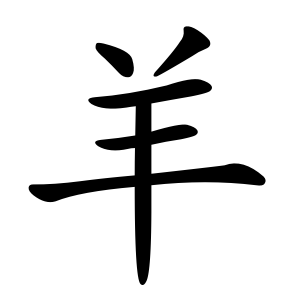羊
- sheep, goat;
Etymology
According to the Shuowen Jiezi (説文解字 shuōwén jiězì), the character represents the whole shape including head, horns, legs, and tail, but from oracle bone script evidence, it primarily depicts the head with horns. Some scholars suggest it originally represented a goat.
Sheep have been domesticated since ancient China, along with horse, cattle, chicken, dog, and pig. Sheep wool was used for textiles, meat for food, and milk was processed for consumption.
Usage in Korean
When 羊 appears as a component in the head position, its vertical stroke ends bluntly (⺷); when used as a radical on the side (the "side variant"), the vertical stroke bends leftward (⺶).
When used as a radical with semantic meaning, it generally relates to sheep or food.
It is also associated with positive concepts such as goodness and beauty, as seen in characters like:
善 (good)
義 (righteousness)
美 (beauty)
羨 (envy/admire)
Words that derived from 羊
- 廿手 (TQ)
- ⿱ 䒑 𰀁
